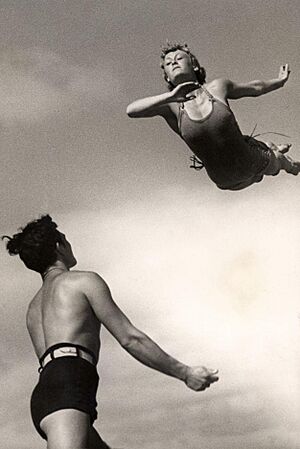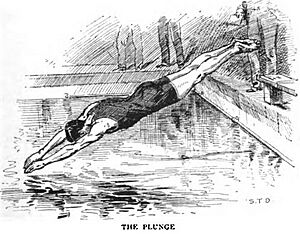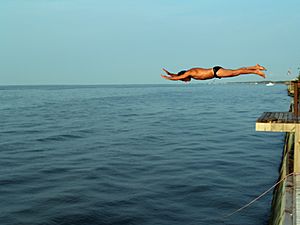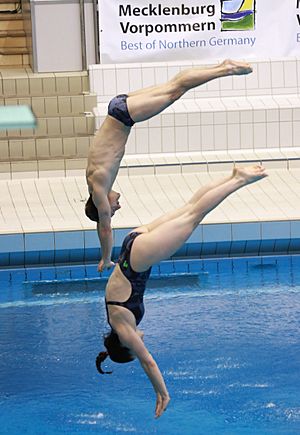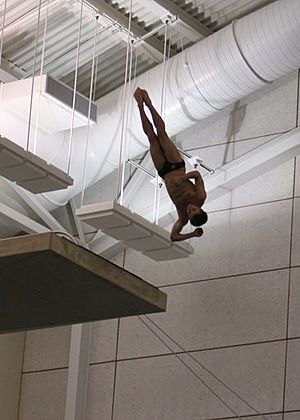Diving (sport) facts for kids
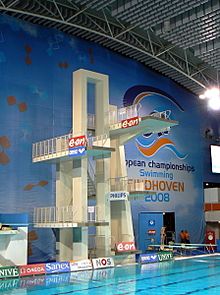
Diving tower at the 2008 Euros
|
|
| Highest governing body | Fédération Internationale de Natation (FINA) |
|---|---|
| Characteristics | |
| Type | Aquatics |
| Presence | |
| Olympic | Part of the Summer Olympic programme since 1904 |
Diving is a cool sport where you jump or fall into water. You usually do this from a platform or springboard, often while doing amazing acrobatics in the air! Diving is a sport known all over the world and is even part of the Olympic Games. Besides competitions, many people also dive just for fun.
Divers need to be strong and flexible, like gymnasts and dancers. They also need to know where their body is in the air without looking. Some professional divers used to be gymnasts or dancers because these sports are quite similar. Dmitri Sautin has won the most Olympic diving medals ever, with eight medals between 1992 and 2008.
Contents
History of Diving
Ancient Dives
One of the oldest pictures of diving is found in the Tomb of the Diver. This tomb, from about 470 BCE, has a painting of a young person diving into wavy water.
Early Competitions
People have enjoyed diving for a very long time. The first modern diving competitions started in England in the 1880s. It probably came from how swimmers would dive into the water at the start of a race.
One early type of competition was called "plunging." In this, divers would jump into the water and see how far they could glide underwater without moving. This competition stopped in 1937.
Fancy Diving Develops
In the early 1800s, gymnasts in Germany and Sweden started diving into water. The soft water landing meant they could try more difficult flips and twists in the air. This led to "fancy diving," which was all about doing acrobatic moves.
In England, people also loved "high diving," which meant diving from tall places. The first diving stages were built in 1893. The first world championship for graceful diving was held in 1895. It included dives from 15 or 30 feet (4.5 or 9 meters) high.
Swedish athletes showed off their fancy diving skills at this event. This helped create the Amateur Diving Association in 1901, which was the first group just for diving.
Diving at the Olympics
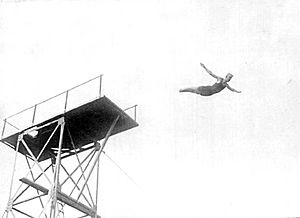
Diving first became an Olympic sport in 1904. In the 1908 Olympics in London, "fancy diving" was added. This was also when springboards were first used instead of fixed platforms. Women were allowed to compete in diving for the first time at the 1912 Olympics in Stockholm.
By the 1928 Olympics, "plain" and "fancy" diving were combined into one event called "Highboard Diving." The first indoor Olympic diving event was held in London in 1948.
Competitive Diving
Most diving competitions have three main events: 1-meter springboard, 3-meter springboard, and platform diving. Divers are grouped by gender and age. For platform diving, competitors can use platforms that are five, seven and a half, nine, or ten meters high. In big events like the Olympic Games, platform diving is always from the 10-meter height.
Divers must perform a certain number of dives. These dives include somersaults and twists. Judges score divers on how well they do each part of the dive. They look at how the diver takes off, how they move in the air, and how little splash they make when they enter the water.
A perfect score is 10 points. This is usually broken down into three points for the takeoff, three for the flight, and three for the entry. One extra point gives judges flexibility.
The score is then multiplied by a "degree of difficulty" (DD) factor. This factor depends on how many moves and how complicated the dive is. The diver with the highest total score after all dives wins.
Synchronized Diving
Synchronized diving became an Olympic sport in 2000. In this event, two divers work as a team. They perform the exact same dive at the same time. Judges score them on how well they do the dive and how perfectly they match each other. This includes matching their take-off, height, and entry into the water.
How Dives are Scored
There are specific rules for scoring a dive. Judges look at three main parts: the approach, the flight, and the entry. Key things that affect the score are:
- How long and well a handstand is held, if required.
- How high the diver goes at the top of the dive. Higher is better!
- How far the diver is from the board. They shouldn't be too close or too far.
- The correct body position for the dive, like pointed toes.
- The right amount of spins and twists.
- The angle of entry into the water. Divers should enter straight, with no angle.
- How much splash is made. Less splash usually means a higher score.
Each dive has a "degree of difficulty" (DD). This number shows how hard the dive is. The judges' scores are multiplied by the DD to get the final score for that dive.
To make scoring fair, especially in big competitions like the Olympics, there are usually seven judges. The two highest and two lowest scores are removed. The remaining three scores are added up and then multiplied by the DD. This helps make sure no single judge can unfairly change the results.
Competitive Strategy
To win a diving competition, divers plan their "dive list" beforehand. They want to get more points than other divers. Simple dives might look good, but they often won't win the competition. Top divers try to do the hardest dives they can perform well.
Divers must submit their dive list before the competition starts. They cannot change their dives after a certain time. If a diver performs a different dive than the one announced, they will get a score of zero.
In big competitions like the Olympics, many divers do similar dives. So, how they arrange their list is important. They often start with a strong, confident dive to build momentum. They might also put a very confident dive just before a very difficult one. This helps them stay focused. Coaches also help divers stay calm during the competition.
Safety in Diving

Even though diving looks risky, serious injuries in supervised training and competitions are very rare.
Most "diving-related" accidents happen when people jump into water that is too shallow. This often happens from bridges or piers. Accidents also occur when people don't check for rocks or logs underwater. That's why many beaches and pools have signs saying "No Diving" in shallow areas or when there's no lifeguard on duty.
In competitive diving, the global body FINA has rules to keep athletes safe. For example, they set limits on how high divers can compete from, based on their age:
- Group D (11 & under): 5 meters
- Group C (12/13 years): 5 meters & 7.5 meters
- Group B (14/15 years): 5 meters, 7.5 meters & 10 meters
- Group A (16/18 years): 5 meters, 7.5 meters & 10 meters
These rules help protect young divers from the risks of diving from very high platforms.
Dive Groups and Positions
Dives are put into six "groups": Forward, Back, Inward, Reverse, Twist, and Armstand. The Armstand group is only for platform diving. The other five groups are for both springboard and platform.
- Forward Group (Group 1): The diver faces forward and spins forward.
- Back Group (Group 2): The diver starts with their back to the water and spins backward.
- Reverse Group (Group 3): The diver faces forward but spins backward.
- Inward Group (Group 4): The diver starts with their back to the water but spins forward.
- Twist Group (Group 5): Any dive that includes a twisting movement.
- Armstand Group (Group 6): Any dive that starts from a handstand (only on platform).
Dive Positions
While a diver is in the air, they hold one of four main body positions:
- Straight: The body is completely straight, with no bends at the knees or hips. This is the hardest position.
- Pike: The knees are straight, but the body is bent tightly at the hips.
- Tuck: The body is folded into a tight ball, with hands holding the shins and toes pointed. This is the easiest position.
- Free: This is used for twisting dives and can be a mix of other positions.
These positions are sometimes called A (straight), B (pike), C (tuck), and D (free). Some dives can also start in a "flying" position, where the diver stays straight for the first part of the dive.
Dive Numbers
In competitions, dives are named using a system of numbers and letters. The first number tells you the dive group.
For groups 1 to 4, the number has three digits and a letter. The third digit shows how many half-somersaults there are. The second digit is 0 or 1. A 0 means a normal somersault, and a 1 means a "flying" dive (where the first half-somersault is done in a straight position).
For example:
- 101A – Forward Dive Straight (1 somersault, straight position)
- 203C – Back one-and-a-half somersaults, tuck (3 half-somersaults, tuck position)
- 305C – Reverse two-and-a-half somersaults, tuck (5 half-somersaults, tuck position)
For Group 5 (twisting dives), the number has four digits. The first digit is always 5. The second digit tells you the group of the main movement (1-4). The third digit is the number of half-somersaults, and the fourth is the number of half-twists.
For example:
- 5211A – Back dive, half twist, straight position.
- 5337D – Reverse one and a half somersaults with three and a half twists, in the Free position.
For Group 6 (Armstand dives), the number has three or four digits.
- Without twists: The second digit shows the direction of spin (0=no spin, 1=forward, 2=backward, 3=reverse). The third digit is the number of half-somersaults.
* 600A – Armstand dive straight * 624C – Armstand back double somersault tuck
- With twists: The number has four digits. The first digit is 6. The second is the direction of spin, the third is half-somersaults, and the fourth is half-twists.
* 6243D – Armstand back double-somersault with one and a half twists in the free position
All these dives have a "Degree of Difficulty" (DD). This number shows how hard a dive is. The score a diver gets is multiplied by the DD to give the final score for that dive.
How Diving Works

When a diver leaves the board, two main things are set: the path of the dive and how much they will spin. These cannot be changed once they are in the air.
However, the diver can change how fast they spin by changing their body shape. If they pull into a tight ball (tuck position), they spin faster. If they stretch out straight, they slow down. This is because of a physics rule called "conservation of angular momentum."
The diver's body follows a curved path, like a rainbow, through the air because of gravity.
Getting Height
It's good for divers to go as high as possible for a few reasons:
- Judges give higher scores for more height.
- More height means more time in the air to do complicated moves.
- Going higher helps the diver land closer to the board, which is also good for scoring.
Controlling Spins
Divers control their spin by changing their body shape. The tuck position (tight ball) gives the most control over spinning speed. Dives in the straight position are the hardest because there's almost no way to change the spin speed once they leave the board.
When divers open their body to enter the water, it doesn't stop the spin completely, but it slows it down a lot. Expert divers make it look like they enter the water perfectly straight, but they often start their entry slightly angled so their legs are vertical as they disappear.
Twisting
Dives with many twists and somersaults are very exciting and difficult. Divers cannot create the twist directly from the take-off. Instead, they use some of their somersaulting spin to create the twisting motion.
They do this by tilting their body sideways after leaving the board. This tilt is often done by moving their arms. For example, if one arm goes up and the other goes down, the body tilts and starts to twist. When they want to stop twisting, they reverse the arm movement.
Entry into Water
Rules say the diver's body should be vertical, or almost vertical, when they enter the water. Divers try to make it look like they are perfectly straight, especially after fast-spinning dives.
For head-first dives, which are most common in competitions, divers put their hands together and extended forward. They hit the water with a flat hand surface. This creates a "vacuum" that helps pull down any splash, making a clean "rip" entry.
Once underwater, divers often roll or scoop in the direction of their dive's spin. This helps pull their legs into a more vertical position and is important for safety. Trying to go against the spin underwater can cause back injuries.
Diving Around the World
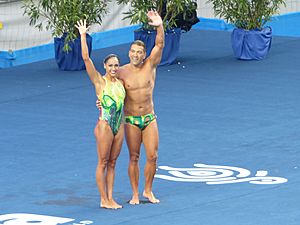
The main organization that controls diving worldwide is FINA. FINA also manages other water sports like swimming and water polo. In most countries, diving is part of the same sports group as swimming.
United States Diving
In the United States, diving is popular at different levels.
Summer Diving
During the summer, many community pools and country clubs have diving programs. These usually focus on 1-meter diving and are open to all school-aged children.
High School Diving
In high school, diving is often part of the swim team. Most high school diving is from the 1-meter springboard, though some schools have 3-meter springboards. The scores from diving contribute to the swim team's total score. High school diving seasons end with state competitions. These usually involve eleven dives: five required dives and six optional dives.
Club Diving
For divers who want to learn 1-meter, 3-meter, or platform diving, there are clubs. These clubs are often part of USA Diving or AAU Diving. Divers start in "Future Champions" and can move up to "Junior Olympic" (JO) levels. JO divers compete in age groups at different competitions, including regional and national events.
USA Diving also holds national championships for older divers, including the Winter Nationals and Summer Nationals. USA Diving chooses the divers who represent the United States in international competitions like the World Championships and the Olympic Games.
College Diving

At the college level, divers compete on 1-meter and 3-meter springboards. Their scores add to the swim team's total. Some colleges also have platform diving, especially in NCAA Division I schools.
College competitions usually involve 6 to 11 dives, depending on the division. Many colleges offer scholarships to talented divers. College students can compete for up to four years.
Masters' Diving
Adults who continue diving after college can join Masters' Diving programs. These programs are for divers of all ages and skill levels, including those new to the sport. Masters' competitions are held in age groups, often separated by five or ten years. The oldest competitor in a Masters' Diving Championship was Viola Krahn, who was 101 years old!
Diving for Fun
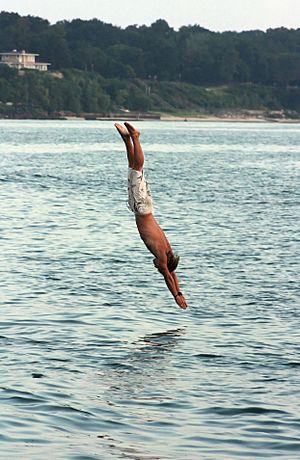
Diving is also a very popular activity just for fun. When people dive for fun, they often focus on the feeling of being in the air and the height of the jump. They don't usually worry about how little splash they make. Knowing how to dive can also be a useful skill in emergencies.
Fun diving can happen indoors or outdoors. Outdoor diving often takes place from cliffs or rocks into lakes or oceans. Sometimes, special platforms are built in popular swimming spots. When diving outdoors, it's very important to know how deep the water is and if there are any currents or hidden rocks.
Sometimes, a diver might accidentally do a "belly flop," landing flat on the water. This usually makes a very big splash!
High Diving
A newer and very exciting part of the sport is High Diving. This is done outdoors, usually from platforms up to 27 meters (about 88 feet) high! This is much higher than the 10-meter platforms used in the Olympics.
Because of the extreme height, high divers always enter the water feet-first to avoid serious injury. They almost always do their last half-somersault backward. This helps them see the water and control their landing.
Competitive high diving is featured in the Red Bull Cliff Diving World Series.
See also
 In Spanish: Salto (natación) para niños
In Spanish: Salto (natación) para niños
- Aquatic timing system
- Cannonball (diving)
- Divers by nationality
- Diving at the Summer Olympics
- La Quebrada Cliff Divers
- List of Olympic medalists in diving
- Scuba diving
- Shallow diving
- List of 10 meter diving platforms in the United States
Images for kids


